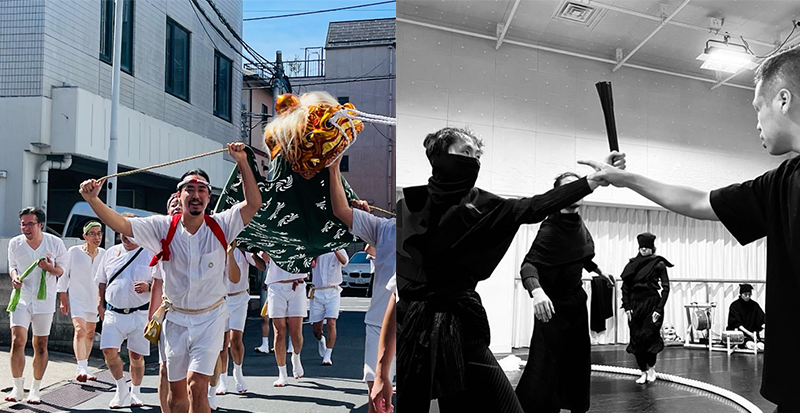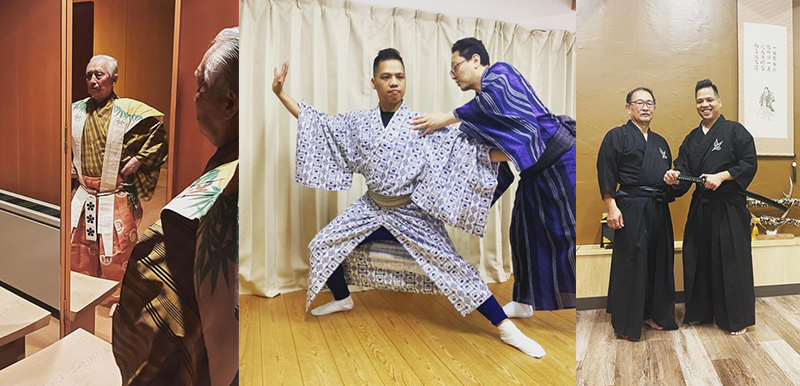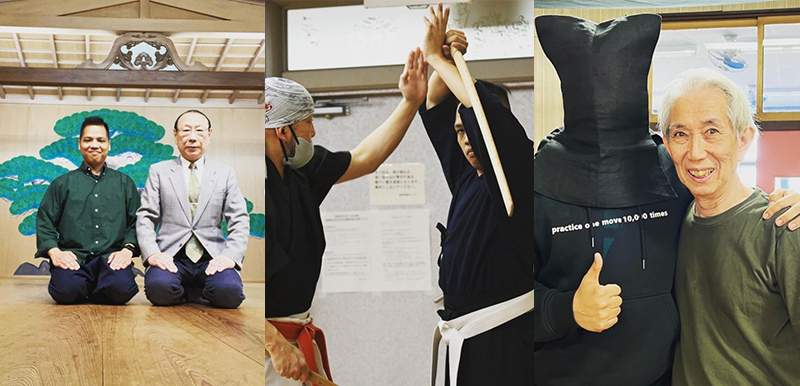Ata WONG (ACC 2021) is a director, choreographer, actor, movement coach and theatre instructor. Wong graduated from the School of Dance at Hong Kong Academy for Performing Arts, and later studied at École Internationale de Théâtre Jacques Lecoq in Paris. He won the Young Artist Award for Drama at the 2017 Hong Kong Arts Development Awards, and is the founder and artistic director of Théâtre de la Feuille, a physical theater company based in Hong Kong. Wong teaches physical theater classes, conducts theater courses at multiple institutions, and is committed to supporting the performing arts and developing young talent.
Wong was supported in his ACC grant activities through the generous sponsorship of the Altius Fellowship by Karen T. Lee.

Ata took up iaido and entered into a competition during his research on performing arts in Japan. 4/16/2023
During my six-month cultural exchange journey in Japan, I was not only enriched by the artistic experiences but also encountered a remarkable group of individuals in Kyojima (京島). These people exuded a genuine sense of optimism about life, dedicated to their passions and being really supportive of one another. It was truly inspiring to witness people of all ages, from teenagers as young as 18 to wise elders of 93, living their lives with vibrancy and happiness. Complaints and burdens seemed to be almost non-existent among them. You may say that the Japanese are not always expressive, or it could be a cultural trait where they are not easily forthright about their struggles.
I am so fortunate, as if I were the protagonist in a role-playing game, where the main character embarks on quests and encounters a diverse array of non-playable characters (NPCs). Each conversation and interaction brings forth a unique storyline. In this journey, the people I had the pleasure of meeting in Kyojima became my unwavering pillars of support, offering encouragement for me to pursue my dreams. Moreover, with the support from Asian Cultural Council (ACC), I had the opportunity to temporarily set aside all my responsibilities and fully immerse myself in the vibrant tapestry of Japanese theater creation. Upon my arrival, I was warmly welcomed by Mrs. Kazuko Aso, the Chairman of ACC Japan, along with her team. Their hospitality and guidance facilitated my connection with a multitude of local artists, while also introducing me to the vibrant community of Kyojima in Sumida Ward, Tokyo.

Photos Ata Wong
Ms. Megumi Shoji is a visual arts curator who has studied theater performance in the UK and France. She is passionate about exploring communication and relationships between people, as well as the connection between life and art. In her role as a visual arts curator, she collaborates with local Japanese artist Mr. Ryota Unno, combining traditional and contemporary culture. Incorporating the realities of modern life and human interactions, he utilizes traditional painting techniques and styles to create artworks that evoke a sense of lightness, mutual smiles, and storytelling.
Mr. Daiki Goto, previously involved in directing and producing documentary films, now dreams of connecting the people and events in the region. He aims to transform abandoned and dilapidated houses in the region into shared living spaces, providing artists with affordable studios or residences. This endeavor represents a grassroots, organic integration of art and community. The region is suffering from aging population and a lack of young labor force. However, through Mr. Daiki Goto's initiatives such as visual arts festivals, shared restaurants, and regular intergenerational activities, this area has become more worthwhile to visit and experience the rich sense of community, surpassing Tokyo's other tourist destinations.
I would like to acknowledge Mr. Yusuke Goto (Kenshi) as well, who carries the noble spirit of the Bushido. Throughout his arduous training, he engages in profound self-reflection, seeking to unravel the intricate relationship between humanity and nature, harmoniously merging the two into a unified existence. Years of self-discipline have fueled Mr. Yusuke Goto’s aspiration to share the essence of Japanese kendo with travelers from all corners of the globe, so now his students are scattered across different continents. I have gained a profound understanding that Japanese kendo extends far beyond the mere act of wielding a sword with brute force. It is a discipline that encompasses intricate details and sacred rituals, all centred around the fundamental values of self-respect and respect for others. This very ethos is why, in Japanese martial arts competitions, the victors seldom display exuberant celebrations after their triumphs, as it is a gesture of reverence towards their defeated opponents.
This pure and simple way of interacting with individuals has been the essence of my experiences over the past six months, and it will continue to be my driving force moving forward.

Photos Ata Wong
《盃 (さかずき) 》”Sakazuki”- is the first song I learned in the traditional Japanese performing art of Kyōgen. Kyōgen is a form of theater with a history of over 600 years. Developed from Sarugaku, it involves humorous interactions with the audience. Its content is simple, improvised, and often utilizing commoner themes, folk customs, and colloquial language to satirize the aristocrats, samurai, and those in power, bringing forth laughter by exposing the common weaknesses of human nature.
The school for Noh theater professors is impossible to find. They exclusively pass down their knowledge to family members, so the only option is to approach the masters directly. I was lucky to have the chance to meet Mr. Zenchiku Jyuro, a renowned Noh actor known as a living national treasure in Japan, thanks to the connection made by Mr. Oriza Hirata, the leader of a Japanese youth theater troupe. Mr. Zenchiku Jyuro, with his extensive experience, began learning Noh theater performances from his grandfather when he was around four years old. He traveled abroad numerous times during his youth, which allowed him to become proficient in multiple languages and can even teach in English.
Almost without realizing it, I spent a whole six months learning from him. We combined chanting with traditional dance, culminating in the portrayal of characters and stories that pushed the boundaries of imagination with graceful simplicity. As my studies progressed, he graciously invited me to assist him in his Noh theater performances on a traditional stage. Just before leaving Japan, I had the incredible opportunity to participate in one of his shows, where we performed a mesmerizing Noh dance and song on a stage brimming with historical significance. It was an unforgettable chapter in both our lives, as we shared the stage and created indelible memories together.
Opportunities for this kind of learning are indeed a matter of chance. Without patience and perseverance, one may not be fortunate enough to have such an experience. Presently, I am able to continue my apprenticeship under the guidance of my master, who also hopes that I will eventually become a member of their esteemed family, assuming the revered role of a performer in Noh theater. There was actually a little anecdote during our first meeting. He introduced me to his family and shared the story of one of his sons who tragically fell victim to pneumonia during the recent pandemic. Despite the sorrowful event, there was no trace of sadness on his face. Instead, he wore a gentle smile as he shared the story. Perhaps it struck me by showing the essence of Noh theater lies not only in mastering the technical skills but also in embodying a resilient and optimistic attitude towards life's myriad joys and sorrows.
In just six short months, I have explored the art of Noh theater and traditional Japanese performing arts, with a particular fascination for the physical training involved. Along the way, I have had the incredible opportunity to learn from a diverse array of masters, delving into disciplines such as swordsmanship, iaido (the art of drawing the sword), dance, puppetry, and mask-making. Each facet of this journey has captivated me with its unyielding dedication to preserving the essence of tradition.
What truly stands out is the masters' spirit of exploration within their own craft. They generously share their techniques, humbly acknowledging that there is always more to learn. Their eagerness to engage in meaningful exchanges with me has deepened my appreciation for the performing arts, offering a profound and multifaceted understanding of artistic expression.

Photos Ata Wong
「一生懸命」"Isshokenmei"- It signifies putting in great effort, exerting oneself to the fullest, and giving everything to pursue a particular endeavor, ultimately achieving mastery in that skill or craft.
Lastly, I would like to express my gratitude to ACC for supporting my cultural exchange journey to Japan and providing me with this wonderful experience. I am also grateful for the presence of my Japanese friends and masters mentioned above, who allowed me to let go of everything and explore the unknown with a pure heart. I firmly believe that the seeds of abundant growth from this journey have been deeply planted within my body and spirit, and I eagerly anticipate the future blossoming of their fruits.
 ACC New York
ACC New York